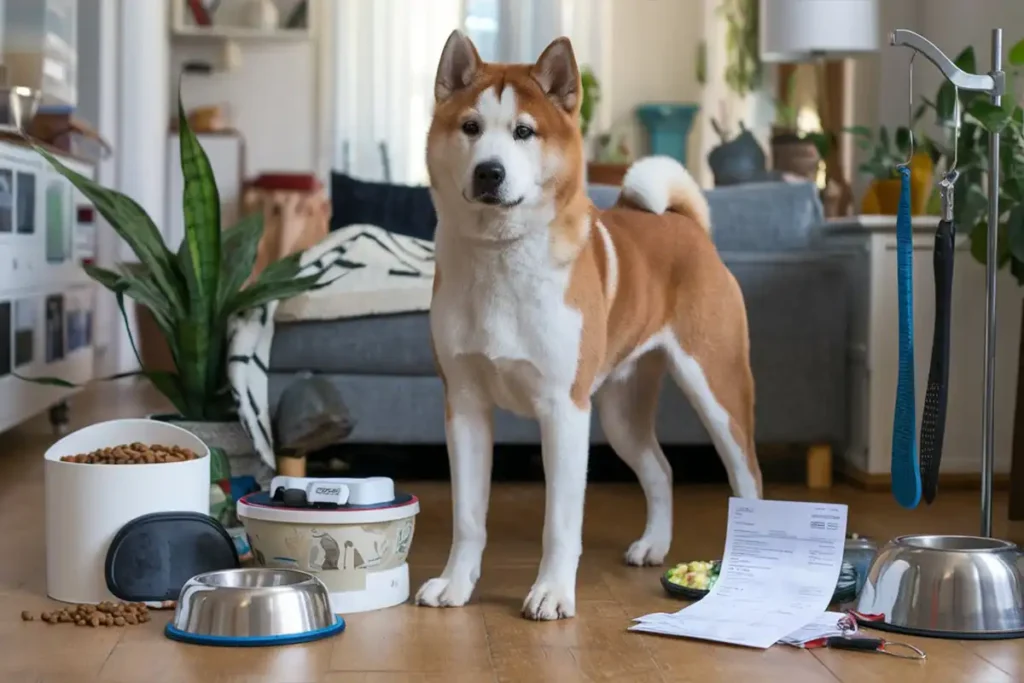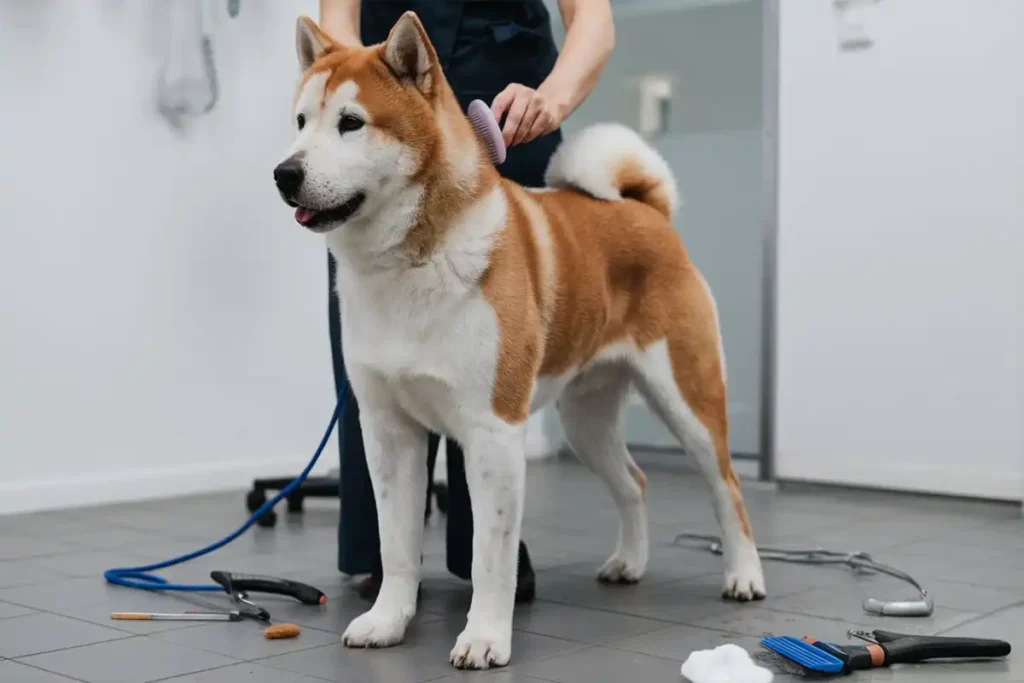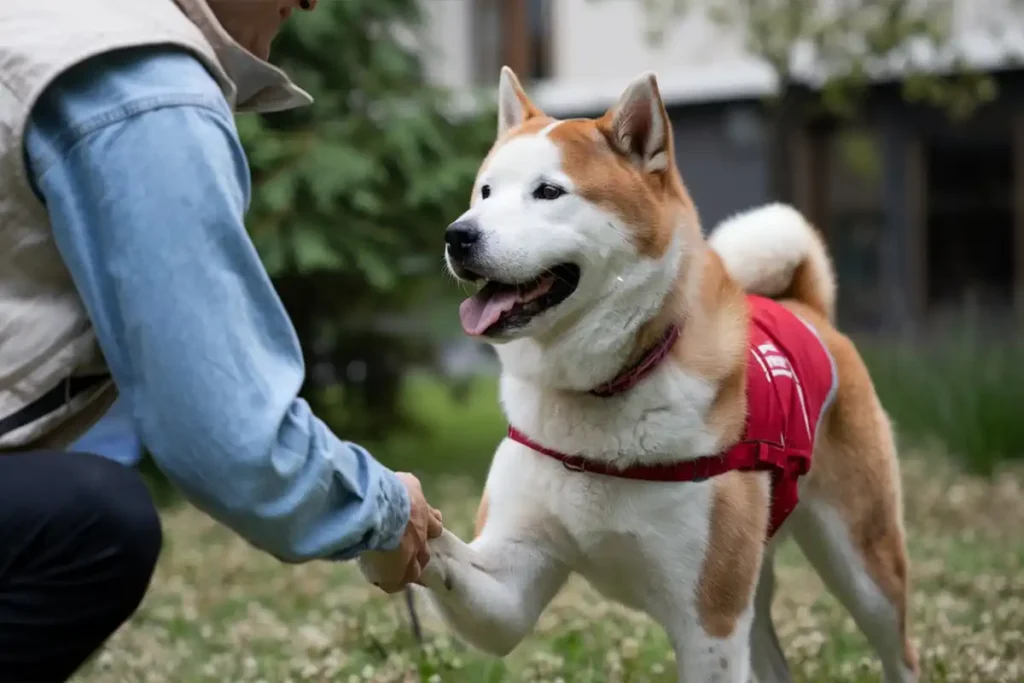Bringing an Akita into your life means more than just owning a dog—you’re gaining a fiercely loyal companion with a noble spirit and striking appearance. But before you make that commitment, it’s important to understand what you’re signing up for financially. The Akita dog price isn’t just about the upfront cost of buying or adopting one. From food and grooming to vet care and insurance, the total cost of owning an Akita can add up quickly—and knowing what to expect can help you make a smart, confident decision.
In this guide, we’ll break down everything you need to know about the real cost of owning an Akita—from puppy prices to monthly maintenance and beyond. Whether you’re exploring adoption, thinking about buying from a breeder, or just curious about what it takes to care for this majestic breed, you’ll get a full picture of what investing in an Akita truly means—both financially and emotionally.
Understanding the Akita Breed and Its Varieties
Akita Inu vs. American Akita: Key Differences
The Akita breed comes in two distinct types: the Akita Inu, which originated in Japan, and the American Akita, which developed in the United States after World War II. While both dogs share a common ancestry, their differences are striking. The Akita Inu tends to have a fox-like face, a narrow frame, and a reserved demeanor. It comes in limited colors like red, white, and brindle, following strict Japanese breed standards. In contrast, the American Akita has a broader head, a more muscular build, and allows for a wider range of coat colors, including pinto and black masks. If you admire elegance and tradition, the Akita Inu might catch your eye. If you prefer a bolder, more robust companion, the American Akita could be the perfect fit.
Before deciding, consider their temperaments, grooming needs, and size differences—they each offer a unique experience for dog lovers. Understanding these differences helps clarify what you’re truly looking for when considering the Akita dog price.
Recognized Standards by the AKC (American Kennel Club)
The American Kennel Club (AKC) recognizes only the American Akita under the name “Akita.” It classifies the Akita as a working group dog, known for its strength, loyalty, and protective instincts. The AKC sets detailed breed standards, including acceptable coat colors, head shape, gait, and overall body structure.
These guidelines ensure consistency among breeders and help preserve the breed’s integrity. While the Akita Inu exists as a distinct breed in Japan, the AKC does not recognize it separately—instead, it treats the Japanese Akita as a variation of the standard Akita. If you’re purchasing a show-quality dog or working with AKC-registered breeders, understanding these standards will help you make informed decisions. The AKC also offers resources for new owners, such as training programs, dog events, and registration services, which add value to the Akita dog price when you consider long-term involvement and support.
What Makes the Akita a Unique and Loyal Companion?
The Akita’s loyalty borders on legendary. Originally bred in Japan for hunting and protection, Akitas naturally form deep bonds with their families and display strong guarding instincts. Unlike more social breeds, Akitas tend to choose one or two people to trust completely. This makes them fiercely devoted but also independent and strong-willed. Their quiet demeanor and dignified presence give them a noble personality, often compared to that of a feline. Akitas don’t bark unnecessarily, but they stay alert to everything around them.
With proper training and socialization, Akitas can be gentle with children and respectful around other pets. Their intense loyalty, intelligence, and courage make them not only excellent watchdogs but also deeply meaningful companions. While their care requires patience and dedication, many owners feel that the emotional bond they share with their Akita far outweighs the Akita dog price.
Are Akitas Considered Purebred Dogs?
Yes, Akitas are considered purebred dogs when they meet the established breed standards recognized by major kennel clubs like the AKC or Japan Kennel Club (JKC). Reputable breeders maintain strict bloodlines and breeding practices to ensure their Akitas conform to physical, behavioral, and health standards. Whether you choose an Akita Inu or an American Akita, both lines offer the potential to be registered as purebred—if documentation supports the lineage. It’s essential to request pedigree papers when purchasing an Akita to verify the dog’s background and avoid unintentional crossbreeding.
Purebred status often impacts not only the dog’s value but also its temperament, appearance, and health outlook. Keep in mind that adopting from shelters may not always guarantee purebred verification, but it can still result in a rewarding experience. Either way, knowing whether you’re getting a purebred helps you understand what influences the Akita dog price and how to best care for your new companion.
Akita Dog Price Breakdown: Puppy Costs & More
Akita Dog Puppy Price from Breeders
When buying from a reputable breeder, the Akita dog price typically ranges from $1,200 to $3,500, depending on the breeder’s reputation, the puppy’s lineage, and location. Show-quality Akitas or those with champion bloodlines may cost even more, often exceeding $4,000. These breeders usually offer health-tested parents, vaccinations, early socialization, and AKC registration, all of which add value to the price. The cost reflects the breeder’s investment in the puppies’ well-being, including prenatal care, vet visits, and high-quality food.
Lower-priced puppies from less reputable sources might lack proper socialization, health guarantees, or breed purity. While the price tag may look tempting, going with a responsible breeder helps ensure your puppy is healthy, well-adjusted, and true to the Akita standard. Ask for documentation, visit the facilities, and meet the puppy’s parents if possible. Taking this route gives you peace of mind and a solid start with your new companion.

How Much is an Akita Dog Through Adoption?
Adopting an Akita from a rescue or shelter usually costs significantly less than buying one from a breeder. On average, adoption fees range from $150 to $600, depending on the organization. These fees typically cover vaccinations, spaying or neutering, and sometimes microchipping. If you’re wondering how much is an Akita dog when adopted, the answer includes more than just a dollar figure.You are also helping a dog that needs a warm and caring home. Many rescue Akitas are adults, which means you can skip the puppy stage and often benefit from some basic training. However, some rescue dogs may require extra patience as they adjust to a new environment. Look into breed-specific rescue groups, as they often provide more in-depth knowledge and support. Adoption offers a budget-friendly and meaningful alternative for those ready to commit to this noble breed.
Akita Adoption vs Buying: Which is Better for You?
Choosing between adoption and buying depends on your lifestyle, goals, and experience as a dog owner. If you’re looking for a specific age, pedigree, or show potential, buying from a breeder may suit your needs. You’ll pay a higher Akita dog price, but you’ll know your dog’s history and health status from the start. On the other hand, adoption offers a chance to give a deserving Akita a second chance at life, often at a much lower cost. You may adopt an older dog, which can mean less training but possibly more medical care down the road.
Consider how much time, money, and emotional energy you can devote. Buying might be ideal if you’re a first-time owner who wants guidance from a breeder. Adoption may be perfect if you’re experienced, compassionate, and open to working with a dog who may need some adjustment time. Both paths lead to a loyal and loving bond—it’s just a matter of how you get there.
Factors That Influence the Akita Breed Cost
Several factors affect the Akita dog price, making it essential to understand what drives the cost before committing. First, location plays a big role—breeders in high-cost-of-living areas may charge more. Next, pedigree matters. Akitas from championship lines or with AKC registration will cost more due to their superior genetics and adherence to breed standards. Health testing also impacts the price, as breeders who invest in screening for hip dysplasia, eye problems, and other common issues provide healthier dogs, which adds to the value.
Coat color and markings can influence cost too, especially if they match desirable standards. Additionally, breeder reputation affects pricing—well-known breeders with waiting lists charge more due to high demand and proven reliability. If you’re choosing between a show-quality Akita and one meant as a companion, expect different pricing tiers. All these elements shape the total investment, so consider both your budget and your long-term commitment before deciding.
Cost of Owning an Akita: Monthly and Annual Expenses
Monthly Expenses for an Akita (Food, Insurance, Supplies)
Owning an Akita involves consistent monthly expenses that can easily range between $150 and $300. Begin with food. A good diet for an Akita dog that matches its size and energy levels usually costs between $60 and $100 each month. Add in treats, supplements, and dental chews, and the number grows. Next, include pet insurance. Premiums vary based on coverage, but most Akita owners pay about $30 to $60 monthly for a solid plan that covers accidents and illnesses.

Then, factor in supplies like poop bags, toys, grooming tools, and replacements for things like beds or collars. Training sessions, daycare, or pet-sitting services can also add to your total if you rely on them. While these monthly costs seem manageable, they add up quickly over the year. When you calculate the Akita dog price, include ongoing care to avoid surprises down the line. A well-prepared budget ensures your Akita gets everything it needs to thrive.
Akita Grooming Cost: What to Expect
Akitas have thick double coats that require regular maintenance to stay clean and healthy. Although they don’t need fancy haircuts, their grooming routine takes time, effort, or money if you outsource it. If you take your Akita to a professional groomer every 4–8 weeks, expect to pay between $60 and $100 per session. Groomers typically include brushing, de-shedding, nail trimming, ear cleaning, and bathing. During heavy shedding seasons—especially spring and fall—you may need more frequent visits or dedicate extra time at home. If you groom your Akita yourself, you’ll still need to invest in tools like a slicker brush, de-shedding rake, nail clipper, and quality shampoo.
Those initial purchases can cost $100 or more, but they last a while. Grooming isn’t just about looks—it keeps your Akita comfortable and reduces hair buildup around your home. When calculating the Akita dog price, don’t overlook this recurring care need, especially if you want to keep your home (and your clothes) fur-free.
Veterinary Bills and Dog Insurance Options
Healthcare is one of the biggest long-term costs of owning an Akita. Routine vet visits for check-ups, vaccinations, and flea/tick prevention cost around $300 to $600 annually. Unexpected illnesses or injuries can lead to much higher bills—some surgeries and treatments easily exceed $2,000. That’s why many Akita owners choose pet insurance. Basic accident-only plans can cost $20–$30 per month, while comprehensive coverage with wellness add-ons may range from $50 to $80 monthly. These policies help reduce the financial burden when emergencies happen.
Also, remember that larger breeds like Akitas are more prone to issues such as hip dysplasia and autoimmune conditions, which may require long-term care. Regular blood work, dental cleanings, and diagnostic tests should also be part of your veterinary planning. Including healthcare in your overall budget helps you manage the full Akita dog price and ensures your dog stays happy and healthy through every life stage.
Akita Food and Care: Quality Nutrition and Routine Needs
Feeding an Akita involves more than just filling a bowl—it means selecting high-quality food that supports their health and longevity. Adult Akitas usually eat between 3 to 5 cups of dry food daily, depending on their weight and activity level. Premium kibble formulated for large breeds costs between $60 and $100 monthly. Some owners opt for raw or fresh food diets, which can raise the cost to over $150 per month. Nutritional supplements, such as omega-3s or joint support, may add another $20–$30. In addition to food, proper care includes daily exercise, training reinforcement, and mental stimulation.
Akitas need structured routines and positive reinforcement to thrive. Don’t forget to budget for chew toys, enrichment tools, and training treats. Quality care keeps your Akita well-behaved and mentally sharp. When you consider the Akita dog price, include the cost of maintaining both physical health and emotional well-being to ensure your investment leads to a fulfilling bond.
Akita Dog Maintenance Cost: What Owners Should Know
Time, Training, and Space Requirements
Akitas need more than food and love—they require time, structure, and the right environment. This breed thrives with firm, consistent training and plenty of mental and physical exercise. You should set aside time every day for structured walks, obedience practice, and engagement. Without enough stimulation, Akitas can become stubborn or destructive. They also benefit from early socialization to ensure they grow into well-balanced adults. If you work long hours or live in a small apartment, an Akita may struggle in your home.

Ideally, Akitas need a securely fenced yard and space to move freely. Their independent nature doesn’t mean they’re low-maintenance—they just need purpose-driven routines and strong leadership. If you hire trainers or attend classes, you’ll likely spend $100 to $200 monthly, especially in the early stages. When assessing the Akita dog price, factor in the time and training tools needed to raise a confident, well-behaved companion.
Routine Care: From Coat Maintenance to Nail Trims
Routine care plays a huge role in your Akita’s well-being and comfort. You should brush their thick fur at least two times a week. When they are shedding fur, it is best to brush them every day. Neglecting this can lead to painful mats, overheating, and excessive hair in your home. You’ll also need to clean their ears regularly, brush their teeth, and trim their nails every few weeks. Some owners feel confident doing this at home, but many rely on groomers or mobile pet services. Nail trimming alone can cost $10 to $20, while full-service grooming runs up to $100 depending on your location. Investing in proper grooming tools for home use may cost $150 initially, but it saves money over time.
Routine care isn’t optional—it directly affects your Akita’s health and behavior. Consider this aspect part of your total Akita dog price, especially if you prefer convenience or professional services to keep your dog looking and feeling their best.
Handling Akita’s Health Conditions and Vet Visits
Akitas are a sturdy breed, but they can develop specific health conditions that require attention throughout their lives. Common issues include hip dysplasia, autoimmune diseases, skin allergies, and progressive eye disorders. Regular vet visits help catch problems early and ensure your dog stays on track with vaccinations, parasite prevention, and dental care. Depending on your vet’s pricing, routine exams can cost $75 to $150, and specialized diagnostics like x-rays or blood work can run much higher. Managing a chronic condition might involve medication, special diets, or regular treatments—all of which can add hundreds to your annual budget.
Pet insurance helps offset some of these expenses, but it doesn’t eliminate them. Knowing your Akita’s risk factors and planning for routine care and occasional emergencies will save you stress and financial strain later. When evaluating the Akita dog price, think beyond the upfront cost and include the possibility of managing long-term health issues.
Choosing Between Local Veterinary Clinics and Specialists
When your Akita needs care, choosing the right provider makes a big difference in both cost and outcome. Local veterinary clinics usually handle routine exams, vaccinations, and basic treatments. These visits cost less and offer the convenience of being close to home. However, some conditions—like joint problems, autoimmune issues, or complex surgeries—may require a visit to a specialist.
Veterinary specialists charge more, sometimes double or triple the rate of a general clinic. For example, a visit to a veterinary dermatologist or orthopedic surgeon could cost $300 to $500 just for a consultation. Add diagnostics, procedures, or follow-ups, and the total grows quickly. If you want top-tier care for your Akita, you need to build a relationship with both a general vet and, when needed, a specialist. When planning for the full Akita dog price, include the cost of high-level veterinary care to ensure you can provide the best treatment no matter what arises.
Making a Smart Investment: Tips for Future Akita Owners
Finding Reputable Dog Breeders or Pet Adoption Agencies
Your experience with an Akita begins with where you choose to get your dog. Finding a reputable breeder or a trustworthy adoption agency can make all the difference in your dog’s health, behavior, and temperament. A responsible breeder provides health clearances, AKC registration, socialization, and often even starter training. They’ll answer your questions, let you meet the puppy’s parents, and explain their breeding ethics. On the adoption side, rescue organizations typically conduct behavioral assessments, vet checks, and may even offer support post-adoption.

Avoid backyard breeders or online sellers who can’t offer documentation or proof of ethical practices. While it may take longer to find the right match, the effort ensures you start off with a healthy, well-adjusted Akita. Whether you choose adoption or a breeder, factor in initial costs and lifetime care. The Akita dog price goes beyond the upfront payment—it starts with choosing a source that values the dog’s welfare as much as you do.
Understanding Long-Term Commitment and Responsibility
Bringing home an Akita means committing to more than just the basics—it’s a 10 to 15-year journey of daily care, training, bonding, and expenses. Akitas are loyal and intelligent, but they require firm leadership, regular socialization, and consistent routines to thrive. You’ll need to manage exercise, grooming, vet care, and training while adapting to your dog’s evolving needs over the years. They aren’t a low-maintenance breed, and they don’t fit every household. You can’t leave them alone for long stretches, neglect their mental stimulation, or skip on training.
Akitas need you to show up—every day—with patience, time, and love. If you travel frequently, work long hours, or prefer low-effort pets, another breed might suit you better. Owning an Akita involves a serious emotional and financial investment. Before you commit, ask yourself whether your lifestyle matches their needs. The Akita dog price isn’t just about money—it’s about the time and energy you’re ready to give.
Budgeting for Hidden Costs (Emergencies, Travel, Boarding)
Planned expenses like food, grooming, and vet checkups are only part of the picture. Owning an Akita also comes with hidden or unexpected costs that can catch you off guard if you’re not prepared. Emergency vet visits can cost $500 to $2,000 or more, depending on the severity of the issue. Travel brings extra considerations—boarding your Akita at a kennel may run $40 to $80 per day, and some facilities charge even more for large breeds.
If you take your Akita with you, you’ll pay for airline-approved crates, travel certifications, and pet fees. Also, budget for replacing chewed-up furniture, training refresher courses, or behaviorists if problems arise. Pet insurance helps reduce risk, but you’ll still need savings set aside. Responsible ownership means planning beyond the basics and being ready for the unexpected. These hidden factors play a big role in the overall Akita dog price—and they’re worth every penny when you’re ready for the commitment.
Is an Akita the Right Fit for Your Lifestyle?
Before you decide on bringing an Akita home, take a deep look at your lifestyle, habits, and personality. Akitas thrive in calm, structured environments where their owners provide firm guidance and daily interaction. If you enjoy long walks, value loyalty, and have the time to train and bond with your dog, the Akita could be a perfect match. However, they don’t do well in chaotic households, cramped apartments, or with passive owners.
Akitas need consistency, space, and a confident leader who sets clear rules. They also tend to be wary of strangers and may not get along well with other pets unless properly socialized early. If you work long hours or travel often, you’ll need reliable backup care. Choosing an Akita should be a thoughtful, informed decision—not an impulse. Matching your lifestyle with the breed’s needs leads to long-term happiness for both of you. When you evaluate the Akita dog price, include the personal investment of time, energy, and compatibility—it’s what truly makes the difference.
Conclusion
Bringing an Akita into your life means so much more than paying a purchase or adoption fee. The Akita dog price includes years of loyal companionship, emotional connection, and a deep bond that only a few breeds can offer. From the moment you choose your Akita—whether through a breeder or adoption agency—you begin a lifelong investment in care, training, and love.
You’ll need to budget not only for the initial Akita dog price but also for monthly costs like food, grooming, and health care. Emergencies, travel needs, insurance, and ongoing training can add more to the total than many expect. However, when you prepare properly, these expenses become part of the meaningful journey of responsible dog ownership.
What truly sets the Akita apart is its unwavering loyalty, strong personality, and protective nature. Owning an Akita requires patience, structure, and daily commitment—but the reward is a fiercely devoted companion who will stand by you through every phase of life.
So, is the Akita dog price worth it? For owners who understand the breed’s needs and are ready to meet them with time, resources, and heart—the answer is a confident yes. Invest wisely, prepare fully, and you’ll gain not just a pet, but a lifetime of loyalty and love.
Read More About Akita Dogs in this Article.
Discover the American Akita Dog Breed in This Article
You Can Discover More About Dogs and Breeds From This Section!
Look for The Best Stuff For your Pet on PetMD Official.
